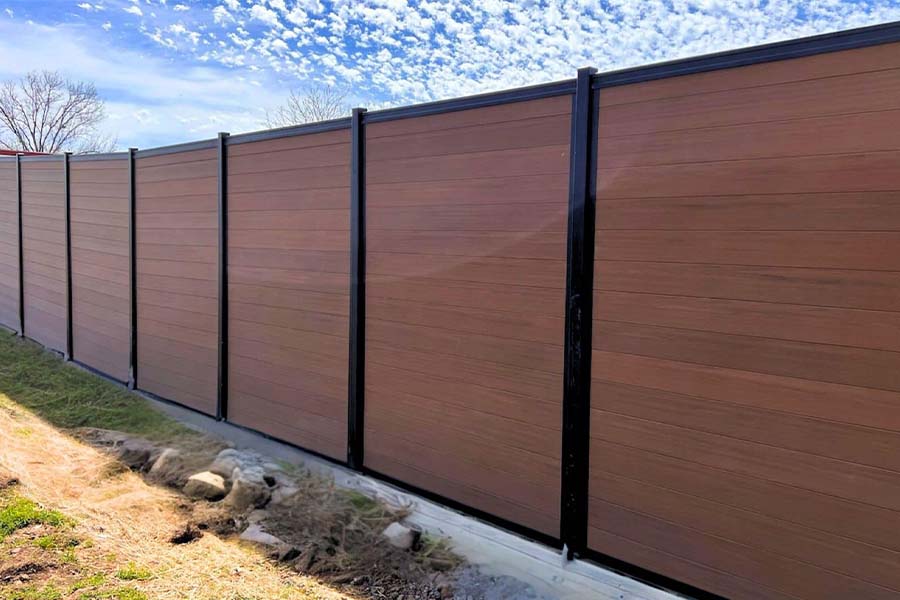All Categories
Featured
Mounting a fencing around your residential property can improve privacy, protection, and appearances. Nonetheless, prior to starting, it's vital to figure out whether you need a license for the installment. Different areas have differing laws, and recognizing what's needed will aid guarantee that your fence is lawful, risk-free, and developed according to local standards. Below's a guide to help you browse the permitting process for fence installment.
Why Are Allows Required? Authorizations are needed to make sure that the installation of your fence satisfies regional building regulations and zoning laws. These regulations remain in location to preserve the safety and security, look, and performance of properties in your neighborhood. Furthermore, allows help stay clear of disagreements with neighbors regarding residential or commercial property lines, fence elevation, and various other architectural details.
Neighborhood authorities call for authorizations to check things like exposure at intersections, public security, and prospective damage to energies like water pipes or electric lines. The process helps maintain your fence task certified with security and legal standards.
Kinds Of Authorizations You Might Require. The exact licenses called for can differ relying on your location and the specifics of your job. Below are one of the most usual sorts of permits you might require:
Building Permit. Numerous cities and counties require a building license for fencings that go beyond a particular height, normally over 6 feet. This permit makes certain that your fencing adheres to architectural criteria, especially if it's made from certain products such as concrete, steel, or block. Structure licenses are additionally required when your fence influences the total landscape, like creating an audio barrier or blocking a sightline.
Zoning Permit. Zoning permits are released to make sure that your fencing follows regional zoning legislations. These legislations might regulate where fencings can be positioned on your residential or commercial property (e.g., yard, side, or front), exactly how high they can be, and whether they can be installed near sidewalks or roads. Zoning laws are established to maintain the overall looks of communities and preserve website traffic safety.
Obstacle License. Some areas have trouble policies that figure out just how much a fencing needs to be from the residential or commercial property line, road, or certain public rooms. Setback authorizations are designed to guarantee that your fence does not disrupt bordering residential properties or public areas. A residential property study may be required to confirm residential or commercial property lines prior to getting this kind of permit.
HOA Approval. You might require to obtain approval from the HOA before setting up a fencing if you live in a neighborhood governed by a Homeowners Organization (HOA) HOAs typically have stringent standards regarding the kind of fence allowed the community, including its height, product, and shade. Always contact the HOA prior to starting your project to prevent any disputes.
Exactly How to Look For a Fence License. The process for acquiring a license typically entails a number of steps:
Research Resident Regulations. Begin by inspecting your city or area's site to discover the certain requirements for fence installation. You might need to see the neighborhood planning or structure division face to face for more comprehensive details.
Prepare Your Application. Many cities will certainly call for an application type, that includes information concerning your planned fencing, such as:
![]()
The kind of fencing product (wood, plastic, chain-link, and so on) The intended elevation of the fencing. The location and dimensions of the fence. A property study (to validate residential property lines) Send the Application. After finishing the application, send it to the neighborhood structure or zoning workplace. You might be called for to pay a fee relying on your area and the size of your fence. Costs can differ, however they typically cover the expense of processing your demand and assessing your strategies.
Wait On Approval. As soon as your application is sent, the regional authorities will evaluate your plans to ensure they fulfill zoning and developing needs. This procedure can take anywhere from a few days to a number of weeks, depending upon the intricacy of the job and the quantity of license requests in your location.
![]()
If Needed),Assessment (. Sometimes, you may need to arrange an examination after the fencing is mounted to ensure it satisfies the needed requirements. If this action is necessary., your neighborhood workplace will let you understand.
When You Do Not Required an Authorization,. Not every fence installation calls for a license. Some situations where you might not require a permit consist of:
Setting up a fencing that's under a particular height (usually 3-4 feet for front backyards) Replacing an existing fence with one that is the same elevation and material. Mounting a short-lived fence (e.g., for building or gardening) Also if your job appears tiny, it's constantly a good idea to check with local authorities to make sure you're following the proper process.
Effects of Not Obtaining an Authorization. Installing a fence without the needed authorization can bring about considerable repercussions, consisting of fines, elimination of the fence, and expensive reinstallation. In many cases, neighborhood authorities might require you to modify the fence if it does not meet code demands. In addition, not getting a permit might create disagreements with neighbors, particularly if the fencing is put inaccurately or breaks regional height policies.
Final thought. Before mounting a fencing, it is essential to research the specific permitting demands in your location. Contact your neighborhood building or zoning department to discover if an authorization is required and to make certain that you're following the appropriate procedure. By protecting the appropriate authorizations, you'll ensure and avoid legal concerns that your fencing installment is secure, certified, and problem-free.
Why Are Allows Required? Authorizations are needed to make sure that the installation of your fence satisfies regional building regulations and zoning laws. These regulations remain in location to preserve the safety and security, look, and performance of properties in your neighborhood. Furthermore, allows help stay clear of disagreements with neighbors regarding residential or commercial property lines, fence elevation, and various other architectural details.
Neighborhood authorities call for authorizations to check things like exposure at intersections, public security, and prospective damage to energies like water pipes or electric lines. The process helps maintain your fence task certified with security and legal standards.
Kinds Of Authorizations You Might Require. The exact licenses called for can differ relying on your location and the specifics of your job. Below are one of the most usual sorts of permits you might require:
Building Permit. Numerous cities and counties require a building license for fencings that go beyond a particular height, normally over 6 feet. This permit makes certain that your fencing adheres to architectural criteria, especially if it's made from certain products such as concrete, steel, or block. Structure licenses are additionally required when your fence influences the total landscape, like creating an audio barrier or blocking a sightline.
Zoning Permit. Zoning permits are released to make sure that your fencing follows regional zoning legislations. These legislations might regulate where fencings can be positioned on your residential or commercial property (e.g., yard, side, or front), exactly how high they can be, and whether they can be installed near sidewalks or roads. Zoning laws are established to maintain the overall looks of communities and preserve website traffic safety.
Obstacle License. Some areas have trouble policies that figure out just how much a fencing needs to be from the residential or commercial property line, road, or certain public rooms. Setback authorizations are designed to guarantee that your fence does not disrupt bordering residential properties or public areas. A residential property study may be required to confirm residential or commercial property lines prior to getting this kind of permit.
HOA Approval. You might require to obtain approval from the HOA before setting up a fencing if you live in a neighborhood governed by a Homeowners Organization (HOA) HOAs typically have stringent standards regarding the kind of fence allowed the community, including its height, product, and shade. Always contact the HOA prior to starting your project to prevent any disputes.
Exactly How to Look For a Fence License. The process for acquiring a license typically entails a number of steps:
Research Resident Regulations. Begin by inspecting your city or area's site to discover the certain requirements for fence installation. You might need to see the neighborhood planning or structure division face to face for more comprehensive details.
Prepare Your Application. Many cities will certainly call for an application type, that includes information concerning your planned fencing, such as:

The kind of fencing product (wood, plastic, chain-link, and so on) The intended elevation of the fencing. The location and dimensions of the fence. A property study (to validate residential property lines) Send the Application. After finishing the application, send it to the neighborhood structure or zoning workplace. You might be called for to pay a fee relying on your area and the size of your fence. Costs can differ, however they typically cover the expense of processing your demand and assessing your strategies.
Wait On Approval. As soon as your application is sent, the regional authorities will evaluate your plans to ensure they fulfill zoning and developing needs. This procedure can take anywhere from a few days to a number of weeks, depending upon the intricacy of the job and the quantity of license requests in your location.

If Needed),Assessment (. Sometimes, you may need to arrange an examination after the fencing is mounted to ensure it satisfies the needed requirements. If this action is necessary., your neighborhood workplace will let you understand.
When You Do Not Required an Authorization,. Not every fence installation calls for a license. Some situations where you might not require a permit consist of:
Setting up a fencing that's under a particular height (usually 3-4 feet for front backyards) Replacing an existing fence with one that is the same elevation and material. Mounting a short-lived fence (e.g., for building or gardening) Also if your job appears tiny, it's constantly a good idea to check with local authorities to make sure you're following the proper process.
Effects of Not Obtaining an Authorization. Installing a fence without the needed authorization can bring about considerable repercussions, consisting of fines, elimination of the fence, and expensive reinstallation. In many cases, neighborhood authorities might require you to modify the fence if it does not meet code demands. In addition, not getting a permit might create disagreements with neighbors, particularly if the fencing is put inaccurately or breaks regional height policies.
Final thought. Before mounting a fencing, it is essential to research the specific permitting demands in your location. Contact your neighborhood building or zoning department to discover if an authorization is required and to make certain that you're following the appropriate procedure. By protecting the appropriate authorizations, you'll ensure and avoid legal concerns that your fencing installment is secure, certified, and problem-free.
Latest Posts
Preventative Maintenance at Montclare Auto Repair: Maintain Your Vehicle Reliable for Years
Published Apr 19, 25
2 min read
Preventative Maintenance at Montclare Auto Repair: Protect Your Vehicle at Peak Performance
Published Apr 19, 25
2 min read
Montclare Auto Repair: The Leading Auto Service Provider in Montclare
Published Apr 19, 25
2 min read
More
Latest Posts
Preventative Maintenance at Montclare Auto Repair: Maintain Your Vehicle Reliable for Years
Published Apr 19, 25
2 min read
Preventative Maintenance at Montclare Auto Repair: Protect Your Vehicle at Peak Performance
Published Apr 19, 25
2 min read
Montclare Auto Repair: The Leading Auto Service Provider in Montclare
Published Apr 19, 25
2 min read